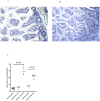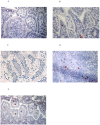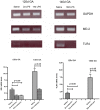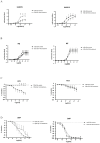Endotoxin induced chorioamnionitis prevents intestinal development during gestation in fetal sheep
- PMID: 19503810
- PMCID: PMC2688751
- DOI: 10.1371/journal.pone.0005837
Endotoxin induced chorioamnionitis prevents intestinal development during gestation in fetal sheep
Abstract
Chorioamnionitis is the most significant source of prenatal inflammation and preterm delivery. Prematurity and prenatal inflammation are associated with compromised postnatal developmental outcomes, of the intestinal immune defence, gut barrier function and the vascular system. We developed a sheep model to study how the antenatal development of the gut was affected by gestation and/or by endotoxin induced chorioamnionitis.Chorioamnionitis was induced at different gestational ages (GA). Animals were sacrificed at low GA after 2d or 14d exposure to chorioamnionitis. Long term effects of 30d exposure to chorioamnionitis were studied in near term animals after induction of chorioamnionitis. The cellular distribution of tight junction protein ZO-1 was shown to be underdeveloped at low GA whereas endotoxin induced chorioamnionitis prevented the maturation of tight junctions during later gestation. Endotoxin induced chorioamnionitis did not induce an early (2d) inflammatory response in the gut in preterm animals. However, 14d after endotoxin administration preterm animals had increased numbers of T-lymphocytes, myeloperoxidase-positive cells and gammadelta T-cells which lasted till 30d after induction of chorioamnionitis in then near term animals. At early GA, low intestinal TLR-4 and MD-2 mRNA levels were detected which were further down regulated during endotoxin-induced chorioamnionitis. Predisposition to organ injury by ischemia was assessed by the vascular function of third-generation mesenteric arteries. Endotoxin-exposed animals of low GA had increased contractile response to the thromboxane A2 mimetic U46619 and reduced endothelium-dependent relaxation in responses to acetylcholine. The administration of a nitric oxide (NO) donor completely restored endothelial dysfunction suggesting reduced NO bioavailability which was not due to low expression of endothelial nitric oxide synthase.Our results indicate that the distribution of the tight junctional protein ZO-1, the immune defence and vascular function are immature at low GA and are further compromised by endotoxin-induced chorioamnionitis. This study suggests that both prematurity and inflammation in utero disturb fetal gut development, potentially predisposing to postnatal intestinal pathology.
Conflict of interest statement
Figures








References
-
- Goldenberg RL, Hauth JC, Andrews WW. Intrauterine infection and pretermdelivery. N Engl J Med. 2000;342:1500–1507. - PubMed
-
- Saji F, Samejima Y, Kamiura S, Sawai K, Shimoya K, et al. Cytokine production in chorioamnionitis. J Reprod Immunol. 2000;47:185–196. - PubMed
-
- Kramer BW, Kramer S, Ikegami M, Jobe AH. Injury, inflammation, and remodeling in fetal sheep lung after intra-amniotic endotoxin. Am J Physiol Lung Cell Mol Physiol. 2002;283:L452–459. - PubMed
-
- Kramer BW, Moss TJ, Willet KE, Newnham JP, Sly PD, et al. Dose and time response after intraamniotic endotoxin in preterm lambs. Am J Respir Crit Care Med. 2001;164:982–988. - PubMed
MeSH terms
Substances
LinkOut - more resources
Full Text Sources
Other Literature Sources
Research Materials

